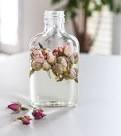The Desired Quality Parameters










The Desired Quality Parameters
I came to know hydrosols as a coproduct of the distillation of essential oils. Therefore the parameters that I have followed in selecting and judging quality in a hydrosol are the same as those that I use for essential oils.
I have always believed that anyone working with natural products must bear in mind environmental issues and, in fact, should cultivate a relationship with the living planet and the energetic elements: earth, air, fire, water and spirit.
The environmentalist David Suzuki, in his book The Sacred Balance, devotes an entire chapter to each of the elements and another to love. From his point of view, we are the air we breathe, the earth from which our food and medicine come, the water from which we are born and of which our bodies are made, and the fire that is the spark that animates all life. I share this view and will talk about aromatherapy and hydrosols in the context of the same philosophy.
Our health is inextricably linked to the health of our planet, Gaia, and we cannot isolate what we do and our pursuit of health into a merely personal experience: it is a global experience, a spiritual path, and a serious responsibility.
Parameters for selecting and evaluating quality in aromatherapy products:
- One single, botanically specific plant
Certified organic or biodynamic agriculture
Chemical-free agriculture
Sustainability wild-crafted and tested chemical contaminants
Distilled or extracted specifically for therapeutic use
Stored and transformed to maintain therapeutic values
Reference: Hydrosols: Suzanne Catty
Articles - Most Read
- Home
- What are Hydrosols
- What are Hydrosols-2
- The Monographs
- How to Make a Hydrosol
- Distilled or Extracted Specifically For Therapeutic Use - 3
- Table of Common Latin Names and pH Values - F - O
- Kurt Schnaubelt
- What isn't a Hydrosol?
- Table of Common Latin Names and pH Values - P - S
- Wholly Water!
- Blue Babies
- Supply and Demands
- Mature Skin
- Recipes Alpha F
- Hydrosols In The Marketplace
- Chemicals: Friends or Foes?
- Hemorrhoids
- Nelly GrosJean
- Water as Medicine
- The Educated Consumer
- Influences
- Genitically Modified Plants
- Water Quality
Articles-latest
- Daucus carota/Wild Carrot Seed - pH 3.8-4.0
- Cupressus sempervirens/ Cypress-pH3.5-3.7
- Coriandrum sativum/Coriander Herb-and-Seed
- Comptonia peregrinal/Sweet Fern- pH 3.8
- Citrus clementine (fe) Clementine Petitgrain- pH 4.3-4.4
- Citrus aurantium var. amara (flos) /Neroli Orange Blossom-pH3.8-4.5
- Cistus ladaniferus/Rock Rose-pH 2.9-3.1
- Cinnamomum zeylanicum (ec) Cinnamon Bark-pH3.3
- Chamaemelum nobile/Roman Chamomile - pH 3.0-3,3
- Centaurea cyanus/Cornflower/Bachelor's Button-pH 4.7-5.0
- Cedrus atlantical/Cedarwood/Atlas Cedar-pH 4.1- 4.2
- Hydrosols -The PH - Anomalies
- Hydrosols- Establishing Shelf Life and Stability
- Boswellia carterii/FRANKINCENSE
- Asarum canadense/ Wild Ginger/Canadian Ginger
- Artemesia vulgaris / Artemesia
- ARTEMESIA DRACUNCULUS - TARRAGON
- Angelica archangelica / Angelica Root - Hydrosols
- The Key, or More Correctly, the pH - 2 - Hydrosols
- The Key, or More Correctly, the pH-Hydrosols
- The Hard pHacts - Hydrosols
- Calamus Root/Sweet Flag - ACORUS CALAMUS
- Yarrow - Achillea millefolium - Hydrosols
- Balsam Fir - Abies balsamea - Hydrosols


